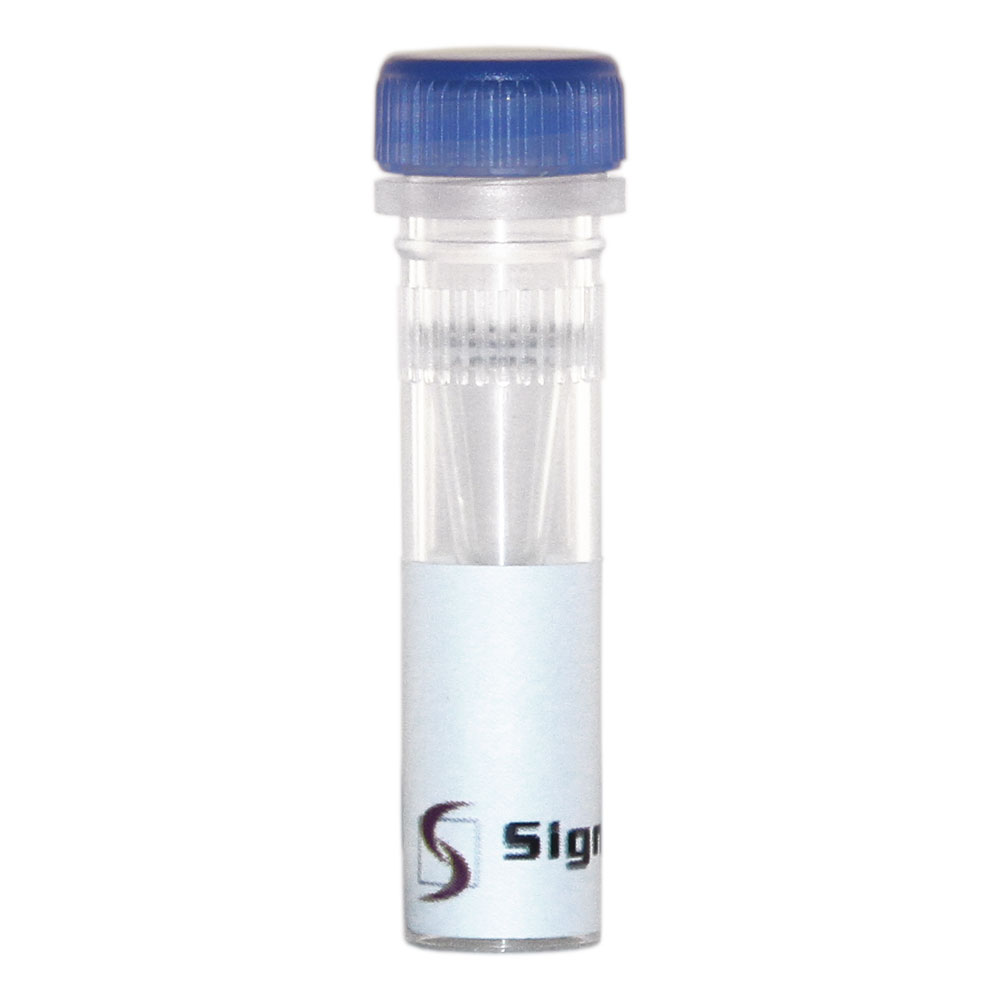
GST Protein
Recombinant artificial sequences GST (1-226) was expressed in E. coli cells and purified on glutathione column.
Catalog No. G52-30U
| Catalog No. | Pack Size | Price (USD) | |
|---|---|---|---|
| G52-30U-20 | 20 ug | $50 | |
| G52-30U-50 | 50 ug | $116 | |
| G52-30U-BULK | BULK | Contact Us |

Recombinant artificial sequences GST (1-226) was expressed in E. coli cells and purified on glutathione column.
Catalog No. G52-30U
| Catalog No. | Pack Size | Price (USD) | |
|---|---|---|---|
| G52-30U-20 | 20 ug | $50 | |
| G52-30U-50 | 50 ug | $116 | |
| G52-30U-BULK | BULK | Contact Us |
Overview:
GST or glutathione S-transferase family of enzymes comprises a long list of cytosolic, mitochondrial, and microsomal proteins that are used to create the so-called GST gene fusion system (1). These proteins are capable of multiple reactions with a multitude of substrates. GST tag has the size of 220 amino acids, which is relatively large compared to other tags like the myc- or the FLAG-tag that are quite small. GST can be used to purify and detect proteins of interest. In a GST gene fusion system, an expression vector consists of the gene sequence encoding the protein of interest and GST sequence alongside. After induction, the fusion proteins can be purified using affinity chromatography via its high affinity for glutathione (1).
Genbank Number:
References:
1. Beckett, G.J. and Hayes, J.D. (1987). Glutathione S-transferase measurements and liver disease in man. J. Clin. Biochem. Nutr. 2, 1-24.
Purity:
Sample Purity Data. For specific information on a given lot, see related technical data sheet.

|
Storage, Stability and Shipping:
Store product at –70oC. For optimal storage, aliquot target into smaller quantities after centrifugation and store at recommended temperature. For most favorable performance, avoid repeated handling and multiple freeze/thaw cycles.
Molecular Weight:
~25 kDa
![]() KH Su et al., HSF1 critically attunes proteotoxic stress sensing by mTORC1 to combat stress and promote growth. Nature Cell Biology May 2016 10.1038/ncb3335
KH Su et al., HSF1 critically attunes proteotoxic stress sensing by mTORC1 to combat stress and promote growth. Nature Cell Biology May 2016 10.1038/ncb3335
![]() J Dai et al., Olig1 Acetylation and Nuclear Export Mediate Oligodendrocyte Development. J Neurosci. December 2015 10.1523/JNEUROSCI.0882-15.2015
J Dai et al., Olig1 Acetylation and Nuclear Export Mediate Oligodendrocyte Development. J Neurosci. December 2015 10.1523/JNEUROSCI.0882-15.2015
![]() A Serrano M et al., DNA-PK, ATM and ATR collaboratively regulate p53-RPA interaction to facilitate homologous recombination DNA repair Oncogene May 2013 10.1038/onc.2012.257
A Serrano M et al., DNA-PK, ATM and ATR collaboratively regulate p53-RPA interaction to facilitate homologous recombination DNA repair Oncogene May 2013 10.1038/onc.2012.257
![]() Jiang Y et al., TOPK promotes metastasis of esophageal squamous cell carcinoma by activating the Src/GSK3β/STAT3 signaling pathway via γ-catenin BMC Cancer December 2020 10.1186/s12885-019-6453-z
Jiang Y et al., TOPK promotes metastasis of esophageal squamous cell carcinoma by activating the Src/GSK3β/STAT3 signaling pathway via γ-catenin BMC Cancer December 2020 10.1186/s12885-019-6453-z
![]() Seoa Jungwon et al., Citron Rho-interacting kinase mediates arsenite-induced decrease in endothelial nitric oxide synthase activity by increasing phosphorylation at threonine 497: Mechanism underlying arsenite-induced vascular dysfunction Free Radical Biology and Medicine January 2016 10.1016/j.freeradbiomed.2015.11.020
Seoa Jungwon et al., Citron Rho-interacting kinase mediates arsenite-induced decrease in endothelial nitric oxide synthase activity by increasing phosphorylation at threonine 497: Mechanism underlying arsenite-induced vascular dysfunction Free Radical Biology and Medicine January 2016 10.1016/j.freeradbiomed.2015.11.020
![]() Krishnamurthy Srinath et al., Active site coupling in PDE: PKA complexes promotes resetting of mammalian cAMP signaling Biophysical Journal July 2014 10.1016/j.bpj.2014.07.050
Krishnamurthy Srinath et al., Active site coupling in PDE: PKA complexes promotes resetting of mammalian cAMP signaling Biophysical Journal July 2014 10.1016/j.bpj.2014.07.050
![]() Wang Ping et al., Beta-arrestin inhibits CAMKKbeta-dependent AMPK activation downstream of protease-activated-receptor-2 BMC Biochemistry September 2010 10.1186/1471-2091-11-36
Wang Ping et al., Beta-arrestin inhibits CAMKKbeta-dependent AMPK activation downstream of protease-activated-receptor-2 BMC Biochemistry September 2010 10.1186/1471-2091-11-36
![]() Kostenko Sergiy et al., Phosphorylation of heat shock protein 40 (Hsp40/DnaJB1) by mitogen-activated protein kinase-activated protein kinase 5 (MK5/PRAK) The International Journal of Biochemistry & Cell Biology February 2014 10.1016/j.biocel.2013.11.004
Kostenko Sergiy et al., Phosphorylation of heat shock protein 40 (Hsp40/DnaJB1) by mitogen-activated protein kinase-activated protein kinase 5 (MK5/PRAK) The International Journal of Biochemistry & Cell Biology February 2014 10.1016/j.biocel.2013.11.004
![]() et al., A LATS biosensor screen identifies VEGFR as a regulator of the Hippo pathway in angiogenesis Nature Communications March 2018
et al., A LATS biosensor screen identifies VEGFR as a regulator of the Hippo pathway in angiogenesis Nature Communications March 2018
![]() et al., IKK ? is a ? -catenin kinase that regulates mesenchymal stem cell differentiation JCI Insight January 2018
et al., IKK ? is a ? -catenin kinase that regulates mesenchymal stem cell differentiation JCI Insight January 2018
![]() et al., LATS kinase�mediated CTCF phosphorylation and selective loss of genomic binding Science Advances February 2020
et al., LATS kinase�mediated CTCF phosphorylation and selective loss of genomic binding Science Advances February 2020
![]() et al., LncRNAs-directed PTEN enzymatic switch governs epithelial�mesenchymal transition Cell Research April 2019
et al., LncRNAs-directed PTEN enzymatic switch governs epithelial�mesenchymal transition Cell Research April 2019
![]() et al., JNK3 phosphorylates Bax protein and induces ability to form pore on bilayer lipid membrane Biochimie Open February 2017
et al., JNK3 phosphorylates Bax protein and induces ability to form pore on bilayer lipid membrane Biochimie Open February 2017
![]() et al., Targeted inhibition of STAT3 induces immunogenic cell death of hepatocellular carcinoma cells via glycolysis Molecular Oncology June 2022
et al., Targeted inhibition of STAT3 induces immunogenic cell death of hepatocellular carcinoma cells via glycolysis Molecular Oncology June 2022
![]() et al., EEF2K silencing inhibits tumour progression through repressing SPP1 and synergises with BET inhibitors in melanoma Clinical and Translational Medicine February 2022
et al., EEF2K silencing inhibits tumour progression through repressing SPP1 and synergises with BET inhibitors in melanoma Clinical and Translational Medicine February 2022
Cancer, Cardiovascular Disease, Cellular Stress, Neurobiology
STAY CONNECTED
Fax: 1-604-232-4601